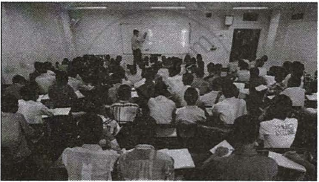Advertisements
Advertisements
प्रश्न
For what value of k, the system of equations
x + 2y = 5,
3x + ky + 15 = 0
has (i) a unique solution, (ii) no solution?
उत्तर
The given system of equations:
x + 2y = 5
⇒ x + 2y - 5 = 0 ….(i)
3x + ky + 15 = 0 …(ii)
These equations are of the forms:
`a_1x+b_1y+c_1 = 0 and a_2x+b_2y+c_2 = 0`
where, `a_1 = 1, b_1= 2, c_1= -5 and a_2 = 3, b_2 = k, c_2 = 15`
(i) For a unique solution, we must have:
∴ `(a_1)/(a_2) ≠ (b_1)/(b_2) i.e., 1/3 ≠ 2/k ⇒ k ≠ `6`
Thus for all real values of k other than 6, the given system of equations will have a unique solution.
(ii) For the given system of equations to have no solutions, we must have:
`(a_1)/(a_2) = (b_1)/(b_2) ≠ (c_1)/(c_2)`
`⇒ 1/3 = 2/k≠ (−5)/15`
`⇒ 1/3 = 2/k and 2/k≠ (−5)/15`
⇒k = 6, k ≠ -6
Hence, the required value of k is 6.
APPEARS IN
संबंधित प्रश्न
Draw the graph of the equation y – x = 2
Find the value of k for which each of the following system of equations have no solution :
3x - 4y + 7 = 0
kx + 3y - 5 = 0
For what value of , the following system of equations will be inconsistent?
4x + 6y - 11 = 0
2x + ky - 7 = 0
Determine the values of a and b so that the following system of linear equations have infinitely many solutions:
(2a - 1)x + 3y - 5 = 0
3x + (b - 1)y - 2 = 0
Solve for x and y:
x + y = 5xy, 3x + 2y = 13xy
The length of a room exceeds its breadth by 3 meters. If the length is increased by 3 meters and the breadth is decreased by 2 meters, the area remains the same. Find the length and the breadth of the room.
Solve for x:
3x2-2x-83=0
Find the value of k, if the point P (2, 4) is equidistant from the points A(5, k) and B (k, 7).
Two straight paths are represented by the equations x – 3y = 2 and –2x + 6y = 5. Check whether the paths cross each other or not.
Read the following passage:
|
A coaching institute of Mathematics conducts classes in two batches I and II and fees for rich and poor children are different. In batch I, there are 20 poor and 5 rich children, whereas in batch II, there are 5 poor and 25 rich children. The total monthly collection of fees from batch I is ₹9,000 and from batch II is ₹26,000. Assume that each poor child pays ₹x per month and each rich child pays ₹y per month.
|
Based on the above information, answer the following questions:
- Represent the information given above in terms of x and y.
- Find the monthly fee paid by a poor child.
OR
Find the difference in the monthly fee paid by a poor child and a rich child. - If there are 10 poor and 20 rich children in batch II, what is the total monthly collection of fees from batch II?

